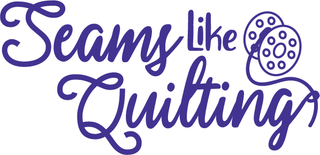A colorful jumble of spools in the bottom of an old cookie tin. Rows of shining cones hung on the wall. Changing the spool right before it runs out. Snapping on the binding of that bag you just have to get done tonight.
Thread brings out all the feels for quilters and sewists. We all have a story of the bobbin running out RIGHT before the end of the row. Or having just enough thread to finish up with a few inches left on the spool. Can learning more about thread itself help prevent some of the drama? With so many thread types (and price points!) out there, how do you decide which thread to use in your next project?
Thread Weight
Before even considering the type of thread, consider the weight of the thread. The smaller the number, the thicker the thread. Yes, it’s that confusing. Thread weight actually refers to how long a thread must be to weigh a kilogram. A thicker thread will be heavier than a thinner thread because less of the thicker thread is required to weigh 1 kilogram.
Basically, just know that most piecing and patchwork threads will be around 50 wt. 30 weight thread will require a needle with a larger eye and is more commonly used for visible hand work. 80 wt thread is very fine, often snaps in machines, and is more commonly used for ‘’invisible” hand work, like applique.
Thread Types
The next consideration is the fiber makeup of the thread. Each have advantages and disadvantages making them useful for particular applications.
Cotton: Strong but not brittle, cotton thread is a natural fiber and has microscopic ‘barbs’ on it that help hold a tight seam. Cotton also holds dye well and has a medium sheen, making it visible when wanted and invisible when not wanted. Quality cotton threads can be expensive and it’s hard to distinguish a high-quality, low-lint thread without testing the thread yourself.
Polyester: Versatile and strong, polyester thread is synthetic and comes in a wide variety of weights, colors, and sheens due to the large variety of manufacturing processes that are possible. However, polyester threads don’t shrink at the same rate as cotton fabric, and can, over time, actually rip cotton fabric fibers, creating small tears in a quilt.
Rayon: Made from cellulose in wood pulp, rayon thread has a high sheen, brilliant colors, and is inexpensive, making it perfect for thread intensive machine embroidery projects. Exposing rayon thread to strong detergents, UV light, or repeated cleaning can create color bleeding and the thread itself is not as strong as polyester.
Nylon: Synthetic thread popular before polyester was developed. It can discolor and become brittle with age and is rarely used now that stronger and more stable synthetic options are available.
Thread Words to Know
In addition to weight and types, there are a few commonly used words when discussing or referencing thread.
Mercerized: A manufacturing process done for basically all modern cotton thread. Basically, mercerized cotton thread is soaked in a solution that swells the cotton before being dyed and dried. The swelling ‘opens’ the natural fibers so dyes are more brilliant and the final thread has more luster.
Gassed: Gassed thread is smoother, brighter, and lower lint. Also called ‘silk finish’ or ‘polished cotton,’ the thread is quickly passed over a flame to burn off the worst of the lint fuzz.
Glazed: Coated or glazed thread is treated with a waxy resin, again to lower lint and increase luster. The glaze also strengthens the thread and is a fantastic option for hand work, especially hand quilting. Typically not recommended for sewing machines, as the waxy resin can build up in the machine’s tension discs and create problems over time.
At Seams Like Quilting, we carry a variety of cotton and polyester threads that quilters commonly use. Check us out at our Spooner, WI store for more details. In the meantime, check out this handy cheat sheet to thread types!


